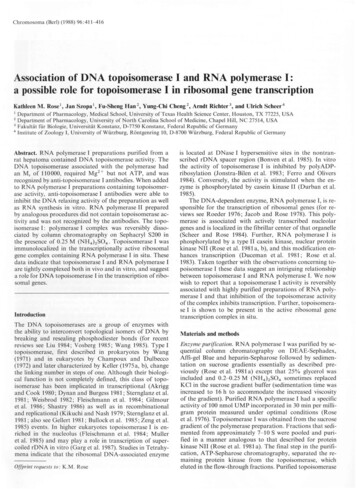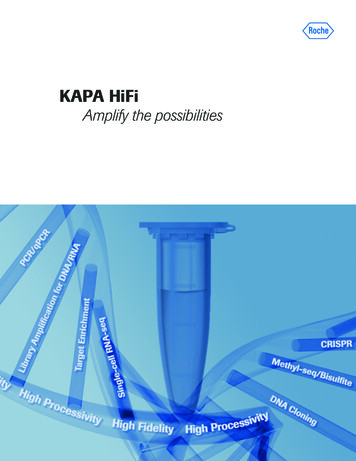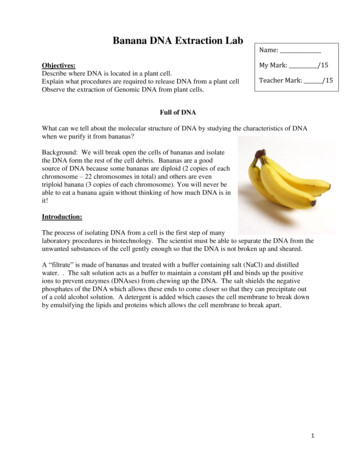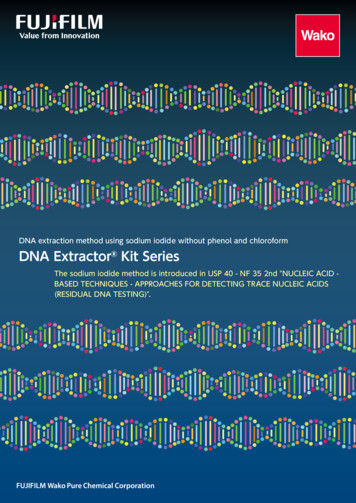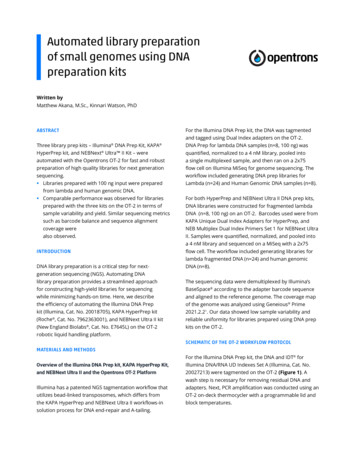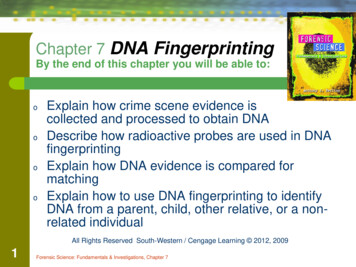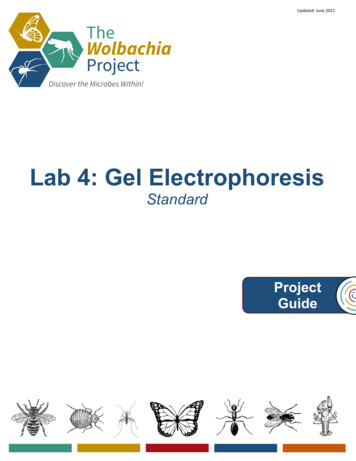
Transcription
Dual Roles for DNA Polymerase Theta in Alternative EndJoining Repair of Double-Strand Breaks in DrosophilaSze Ham Chan1., Amy Marie Yu1., Mitch McVey1,2*1 Department of Biology, Tufts University, Medford, Massachusetts, United States of America, 2 Program in Genetics, Tufts Sackler School of Graduate Biomedical Sciences,Boston, Massachusetts, United States of AmericaAbstractDNA double-strand breaks are repaired by multiple mechanisms that are roughly grouped into the categories of homologydirected repair and non-homologous end joining. End-joining repair can be further classified as either classical nonhomologous end joining, which requires DNA ligase 4, or ‘‘alternative’’ end joining, which does not. Alternative end joininghas been associated with genomic deletions and translocations, but its molecular mechanism(s) are largely uncharacterized.Here, we report that Drosophila melanogaster DNA polymerase theta (pol theta), encoded by the mus308 gene andpreviously implicated in DNA interstrand crosslink repair, plays a crucial role in DNA ligase 4-independent alternative endjoining. In the absence of pol theta, end joining is impaired and residual repair often creates large deletions flanking thebreak site. Analysis of break repair junctions from flies with mus308 separation-of-function alleles suggests that pol thetapromotes the use of long microhomologies during alternative end joining and increases the likelihood of complex insertionevents. Our results establish pol theta as a key protein in alternative end joining in Drosophila and suggest a potentialmechanistic link between alternative end joining and interstrand crosslink repair.Citation: Chan SH, Yu AM, McVey M (2010) Dual Roles for DNA Polymerase Theta in Alternative End-Joining Repair of Double-Strand Breaks in Drosophila. PLoSGenet 6(7): e1001005. doi:10.1371/journal.pgen.1001005Editor: R. Scott Hawley, Stowers Institute for Medical Research, United States of AmericaReceived September 15, 2009; Accepted May 27, 2010; Published July 1, 2010Copyright: ß 2010 Chan et al. This is an open-access article distributed under the terms of the Creative Commons Attribution License, which permitsunrestricted use, distribution, and reproduction in any medium, provided the original author and source are credited.Funding: This work was supported by a grant from the NSF (MCB-0643253) and by a New Scholar in Aging award to MM from the Ellison Medical Foundation(www.ellisonfoundation.org). The funders had no role in study design, data collection and analysis, decision to publish, or preparation of the manuscript.Competing Interests: The authors have declared that no competing interests exist.* E-mail: mitch.mcvey@tufts.edu. These authors contributed equally to this work.eukaryotes, Ku70/80 also recruits DNA-PKcs, forming a synapticcomplex that can recruit additional processing enzymes such asthe Artemis nuclease and the X family DNA polymerases mu andlambda. These proteins expand the spectrum of broken ends thatcan be rejoined. The second core complex, composed of DNAligase 4, XRCC4, and XLF/Cernunnos, catalyzes ligation of theprocessed ends. Depending on the substrate, C-NHEJ can result inperfect repair of broken DNA, or it can result in small deletions of1–10 nucleotides and/or insertions of 1–3 nucleotides [7].Although C-NHEJ can repair blunt-ended substrates, a subset ofC-NHEJ products appear to involve annealing at 1–4 nucleotidemicrohomologous sequences on either side of the break.Alternative end-joining (alt-EJ) is defined as end-joining repairthat is observed in cells or organisms lacking one or more C-NHEJcomponents (reviewed in [8]). Alt-EJ in yeast is associated withdeletions larger than those typically created by C-NHEJ, togetherwith an increased tendency to repair by annealing at microhomologous sequences. Ku and ligase 4-independent end joiningobserved in mammalian cells also displays an increased tendencytowards use of short microhomologies compared to C-NHEJ[9,10]. Therefore, alt-EJ is sometimes called microhomologymediated end joining (MMEJ) [11]. However, the relationshipbetween MMEJ and alt-EJ is still unclear, and alt-EJ may compriseone or more C-NHEJ-independent repair mechanisms [8].The importance of alt-EJ repair is highlighted by multiplestudies that suggest it may promote chromosome instability andcarcinogenesis. Alt-EJ produces chromosome translocations inIntroductionDNA double-strand breaks (DSBs) and interstrand crosslinkspose serious threats to cell survival and genome stability. Becausethese lesions compromise both strands of the double helix, theyimpede DNA replication and transcription and therefore must beremoved in a timely and coordinated manner. Interstrandcrosslink repair has been shown to involve a DSB intermediatein some cases (reviewed in [1]). Therefore, there may besubstantial mechanistic overlap in the processes used duringrepair of these two lesions.Error-free repair of DSBs can be accomplished throughhomologous recombination (HR) with an undamaged homologoustemplate (reviewed in [2]). However, in contexts where suitabletemplates for HR do not exist, error-prone repair mechanisms arealso used. For example, non-homologous end joining (NHEJ)frequently creates small insertions and deletions during DSBrepair, particularly in cases where the broken ends cannot bereadily ligated (reviewed in [3]). Analogously, the use of translesionDNA polymerases during interstrand crosslink repair can result inmutations, due to the reduced fidelity of these polymerases [4,5].Accumulating evidence suggests that NHEJ is composed of atleast two genetically distinct mechanisms. Classical NHEJ (CNHEJ) involves the sequential recruitment of two highly conservedcore complexes (reviewed in [6]). First, the Ku70/80 heterodimerrecognizes and binds to DNA ends in a sequence-independentmanner, thereby protecting them from degradation. In manyPLoS Genetics www.plosgenetics.org1July 2010 Volume 6 Issue 7 e1001005
DNA Pol h Promotes Alt-EJcertain interstrand crosslink-sensitive cell lines from FanconiAnemia patients are also impaired in DNA-PKcs-independentrejoining of linearized plasmids [25]. Based on these reports, wehypothesized that additional mechanistic insight into bothinterstrand crosslink repair and alt-EJ could be gained bysearching for mutants defective in both processes. To test this,we have screened Drosophila mutants that are sensitive to DNAcrosslinking agents for additional defects in alt-EJ repair. In thiswork, we describe our studies with one such mutant, mus308.The mus308 (mutagen sensitive 308) mutant was originallyidentified by its extreme sensitivity to interstrand crosslinkingagents but normal resistance to alkylating agents [26]. Subsequently, mus308 was found to code for DNA polymerase theta,which is most similar to A family DNA polymerases such asEscherichia coli Pol I [27]. Orthologs of polymerase theta (hereafterreferred to as pol h) are found in many metazoans, includingCaenorhabditis elegans, Arabidopsis thaliana, and Homo sapiens, but not inunicellular eukaryotes, including the yeasts [28–30]. Several linesof evidence suggest that pol h may play an important role inmaintaining genome stability. Similar to flies, C. elegans withmutations in POLQ-1 are defective in repair of interstrandcrosslinks [28]. Mice lacking pol h (chaos1 mutants) have a highfrequency of spontaneous and mitomycin C-induced micronucleiin erythrocytes, consistent with genomic instability [31]. Inaddition, vertebrate pol h orthologs have been implicated in awide range of repair processes, including base excision repair,bypass of abasic sites, and somatic hypermutation of immunoglobulin genes [32–36]. Finally, upregulation of pol h is observedin a variety of human tumors and is associated with a poor clinicaloutcome, suggesting that its overexpression may contribute tocancer progression [37].Pol h is unusual in possessing an N-terminal helicase-like domainand a C-terminal polymerase domain. Although pol h purified fromhuman cell lines and Drosophila has error-prone polymerase activityand single-stranded DNA-dependent ATPase activity, helicaseactivity has not been demonstrated in vitro [30,38,39]. Therefore, itremains unclear exactly how the structure of pol h relates to itsmultiple functions in DNA repair in different organisms.We report here that in addition to its role in DNA interstrandcrosslink repair, Drosophila pol h is involved in end-joining repairof DSBs. This alt-EJ mechanism operates independently of bothRad51-mediated HR and ligase 4-dependent C-NHEJ. Geneticanalysis using separation-of-function alleles provides support fordistinct roles of both the N- and C-terminal domains of pol h inalt-EJ. Collectively, our data support a model in which helicaseand polymerase activities of Drosophila pol h cooperate togenerate single-stranded microhomologous sequences that areutilized during end alignment in alt-EJ.Author SummaryDNA double-strand breaks, in which both strands of theDNA double helix are cut, must be recognized andaccurately repaired in order to promote cell survival andprevent the accumulation of mutations. However, errorprone repair occasionally occurs, even when accuraterepair is possible. We have investigated the geneticrequirements of an error-prone break-repair mechanismcalled alternative end joining. We have previously shownthat alternative end joining is frequently used in the fruitfly, Drosophila melanogaster. Here, we demonstrate that afruit fly protein named DNA polymerase theta is a keyplayer in this inaccurate repair mechanism. Geneticanalysis suggests that polymerase theta may be importantfor two processes associated with alternative end joining:(1) annealing at short, complementary DNA sequences,and (2) DNA synthesis that creates small insertions atbreak-repair sites. In the absence of polymerase theta, abackup repair mechanism that frequently results in largechromosome deletions is revealed. Because DNA polymerase theta is highly expressed in many types of humancancers, our findings lay the groundwork for furtherinvestigations into how polymerase theta is involved inrepair processes that may promote the development ofcancer.mouse embryonic stem cells lacking Ku70 [12] and the use of altEJ during V(D)J recombination in C-NHEJ-deficient murinelymphocytes causes complex chromosome translocations andprogenitor B cell lymphomas [13]. Furthermore, alt-EJ has beenimplicated in various translocations associated with chronicmyeloid leukemia and human bladder cancer [14,15]. Importantly, alt-EJ also operates during V(D)J rejoining in C-NHEJproficient B lymphocytes [16], suggesting that its role in DSBrepair is not limited to situations where C-NHEJ is defective.However, alt-EJ is frequently masked by more dominant repairprocesses that are essential for vertebrate development, making itdifficult to study. Therefore, its molecular mechanisms and theproteins involved remain largely unknown.Several lines of evidence demonstrate that Drosophila is anexcellent model system in which to study alt-EJ in a metazoan. TheDrosophila genome lacks several mammalian C-NHEJ components,including DNA-PKcs and Artemis. This may predispose flies towardsnon-C-NHEJ repair. Consistent with this, we have previously shownthat a DSB caused by excision of a P element transposon in flies isreadily repaired by a DNA ligase 4-independent end-joining process[17]. Interestingly, although Drosophila orthologs for the Pol Xfamily DNA polymerases mu and lambda have not been identified[18], we and others have found evidence for polymerase activity inDrosophila end-joining repair [17,19,20]. Specifically, end joining inflies is often associated with the insertion of nucleotides at repairjunctions, frequently involving imperfect repeats of 5–8 nucleotides.Full or partial templates for the insertions, occasionally possessingmismatches, can often be identified in adjacent sequences, suggestingthe action of an error-prone polymerase. Similar templatednucleotides (T-nucleotides) have previously been identified attranslocation breakpoints in human lymphomas [21–23]. Therefore,T-nucleotides could represent a signature of alt-EJ and may beinformative regarding its molecular mechanisms.Additional insight into alt-EJ is provided by recent reportssuggesting a mechanistic link between alt-EJ and interstrandcrosslink repair. For example, a study of two Chinese hamsterovary cell lines sensitive to the crosslinking agent mitomycin Cfound that they were also deficient in alt-EJ [24]. Furthermore,PLoS Genetics www.plosgenetics.orgResultsDrosophila pol h is important for both interstrandcrosslink repair and end-joining repair of DNA doublestrand breaksDrosophila mus308 mutants were initially identified based ontheir sensitivity to low doses of chemicals that induce DNAinterstrand crosslinks [26]. To confirm this phenotype, weassembled a collection of previously identified mus308 mutantalleles [40,41] and measured the ability of hemizygous mutantlarvae to survive exposure to the crosslinking agent mechlorethamine (nitrogen mustard). Of the mutants that we tested, four wereunable to survive exposure to 0.005% mechlorethamine: D2, D5,2003, and 3294 (data not shown), consistent with their inability torepair interstrand crosslinks.2July 2010 Volume 6 Issue 7 e1001005
DNA Pol h Promotes Alt-EJtype of HR) and end joining (EJ) (Figure 3A) [43]. We havepreviously shown that the majority of end joining observed in thisassay occurs independently of DNA ligase 4, and is therefore aform of alt-EJ [17]. In this system, excision of a P element (P{wa})located on the X chromosome is catalyzed by P transposase,resulting in a 14-kilobase gap relative to an undamaged sisterchromatid. The DNA ends remaining after excision each have 17nucleotide non-complementary 39 single-stranded overhangs [44].These ends are highly recombinogenic and repair by SDSA isinitially favored. However, because repair synthesis in this systemis not highly processive, most repair products that are recoveredfrom wild-type flies result from incomplete repair synthesis fromone or both sides of the break, followed by end joining of thenascent DNA (SDSA EJ events) [45]. To quantitate thepercentage of repair events that derive from each mechanism,repair events are recovered from male pre-meiotic germline cellsby mating individual males to females homozygous for the P{wa}element. Each of the resulting female progeny represents a singlerepair event that can be classified by eye color. Red eyed-femalesinherit a repair event involving homology-dependent synthesis thatgenerated complementary single-stranded regions that subsequently anneal (repair by SDSA). Yellow-eyed females inherit achromosome that was repaired by EJ or SDSA EJ mechanisms(these repair events are hereafter referred to as (SDSA) EJ; forfurther details, see Materials and Methods).Overall, the results from the P{wa} assay indicated that mus308mutants are defective in end-joining repair of DSBs. We observedno decrease in the percentage of red-eyed progeny recovered frommus308 mutant males (Figure 3B), suggesting that SDSA repair isnot impaired when pol h is missing or defective. In contrast, allfour mus308 mutant alleles resulted in a significantly decreasedpercentage of yellow-eyed progeny relative to wild type (p,0.001,Kruskal-Wallis test). Because yellow-eyed progeny can only resultfrom a repair mechanism involving end joining, these data suggestthat pol h is involved in an end-joining process.To further demonstrate that pol h is not involved in DNAsynthesis during SDSA, we recovered independent (SDSA) EJevents in males, isolated genomic DNA, and used PCR to estimatethe approximate amount of DNA repair synthesis that occurredprior to end joining. The amount of repair synthesis in (SDSA) EJrepair products did not differ significantly between wild-type andmus308 mutant flies (Figure 3C). We conclude that pol h is notrequired for DNA synthesis during SDSA, but plays an importantrole in end-joining repair following aborted SDSA.To determine the molecular lesions responsible for mechlorethamine sensitivity, we sequenced the entire mus308 codingregion of flies hemizygous for each mutant allele. Pol h possessesboth a conserved N-terminal helicase-like domain and a Cterminal pol I-like polymerase domain (Figure 1, Figure S1) [30].Three of the four alleles contain unique sequence changes that arepredicted to affect pol h primary structure (Figure 1, Figure S2,and Figure S3). The 2003 allele is a nonsense mutation upstreamof the polymerase domain, while the D5 allele is a missensemutation that alters a highly conserved proline in the conserved Nterminus. The 3294 allele changes an invariant glycine in thehelicase domain to serine. Interestingly, this residue is conserved inthe related mus301 helicase, but not in other DNA helicases (datanot shown). No mutations were found in the coding sequence ofthe D2 allele. Because homozygous D2 flies have undetectablelevels of pol h protein [38], the D2 mutation may affect aregulatory region of mus308.One explanation for the extreme sensitivity of mus308 mutantsto mechlorethamine could be a defect in the repair of certain typesof DSB intermediates that are created during crosslink repair. Totest this, we exposed flies hemizygous for each mutant allele toincreasing doses of ionizing radiation (IR). Although IR createsmany different types of lesions, unrepaired DSBs are thought to bethe main cause of cell death following irradiation. All four mus308mutants survived IR exposures as high as 4000 rads (Figure 2A),although bristle and wing defects characteristic of apoptotic celldeath were frequently observed at high doses. Drosophila lig4mutants, which are completely defective in C-NHEJ, also surviveIR doses in excess of 4000 rads [17]. However, spn-A mutants,which lack the Rad51 recombinase required for strand invasionduring homologous recombination initiation [42], are highlysensitive to IR [17]. Thus, in Drosophila, HR is the dominantmechanism used to repair IR-induced DSBs.To test whether pol h acts to repair IR damage in the absence ofHR, we created mus308 spn-A double mutants and exposed themto doses of 125–1000 rads. Strikingly, doses as low as 125 radsresulted in almost complete killing of mus308 spn-A mutants(Figure 2B). In contrast, lig4 spn-A double mutants are only slightlymore sensitive than spn-A single mutants to IR [17]. Thus, in theabsence of HR, pol h participates in a process crucial for repair ofdamage caused by ionizing radiation.Because interstrand crosslink repair and alternative end joininghave been shown to have partially overlapping genetic requirements in mammals [24,25], we hypothesized that the extremesensitivity of mus308 spn-A mutants to IR might relate to a role ofpol h in an alternative end-joining mechanism. To explore thishypothesis, we tested each mus308 mutant allele using a sitespecific double-strand break repair assay that can distinguishbetween synthesis-dependent strand annealing (SDSA, a specificDSB repair in mus308 mutants frequently results inRad51-independent genomic deletionsMutations that abolish end joining in flies cause an increasedfrequency of genomic deletions during repair of site-specific DSBsFigure 1. Schematic of the mus308 gene. Exons are represented by boxes. The helicase-like domain (light gray shading) and polymerase domain(dark gray shading) are shown. Locations of the D5, 3294, and 2003 point mutations are indicated with arrows (numbers correspond to amino acidpositions in the protein). Not shown is the D2 mutation, which results in severely reduced levels of pol h.doi:10.1371/journal.pgen.1001005.g001PLoS Genetics www.plosgenetics.org3July 2010 Volume 6 Issue 7 e1001005
DNA Pol h Promotes Alt-EJFigure 2. Drosophila pol h is required for repair of IR–induced damage in the absence of Rad51. (A) mus308 mutants are not sensitive toionizing radiation. Female flies heterozygous for the indicated mus308 alleles were mated to Df(3R)Sz29/TM3 males and third instar larval progenywere irradiated with increasing doses of IR. The percent survival of mus308 hemizygous mutants was calculated relative to an unirradiated control.Each dose was repeated twice; the average of the two experiments is shown. (B) spn-A mus308 double mutants are extremely sensitive to ionizingradiation. Heterozygous spn-A057mus308D5 females were mated to heterozygous spn-A093mus308D5 males and third instar larval progeny wereirradiated with increasing doses of IR. The percent survival of spn-A mus308 compound heterozygotes was calculated relative to an unirradiatedcontrol. Each dose was repeated at least twice. Error bars represent standard 6,47]. To determine whether mutation of mus308 also results inrepair-associated deletions, we took advantage of the fact thatdeletions can be easily scored in the P element excision assay.Because P{wa} is inserted in the essential scalloped (sd) gene, repairevents that delete into sd exons cause a scalloped-wing phenotypewhen recovered in heterozygous females and lethality inhemizygous males [48,49]. We observed a substantial increase inPLoS Genetics www.plosgenetics.orgthe percentage of deletion-associated repair events isolated frommus308 mutant males relative to wild type (Figure 3D). Overall, thetotal percentage of end-joining repair events involving deletionsrecovered from mus308 mutants was elevated from 3- to 26-foldover wild type, depending on the mus308 allele tested.Previously, we observed a similar deletion-prone phenotype inflies lacking the DmBlm protein, which is involved in repair of4July 2010 Volume 6 Issue 7 e1001005
DNA Pol h Promotes Alt-EJFigure 3. Pol h is involved in end-joining repair. (A) A P element excision assay monitors DSB repair outcomes. The P{wa} transposon is insertedin a 5.2 kb intron of the essential scalloped (sd) gene. A copia retrotransposon flanked by long terminal repeats (LTR) is inserted into an exon of thewhite gene, causing reduced expression of white. Excision of P{wa} results in a 14-kilobase gap relative to an intact sister chromatid. Followingexcision, repair events from the male pre-meiotic germline are recovered in female progeny and the method of repair is inferred from their eye color.SDSA synthesis-dependent strand annealing, SDSA EJ SDSA end joining, EJ end joining. Accompanying deletion into sd exons (EJ withdeletion) results in a scalloped-wing phenotype and/or male lethality. (B) Pol h mutants are defective specifically in end-joining repair of DSBs. Eachbar represents the mean percentage of repair events recovered from independent males possessing the indicated mus308 allele in trans toPLoS Genetics www.plosgenetics.org5July 2010 Volume 6 Issue 7 e1001005
DNA Pol h Promotes Alt-EJDf(3R)Sz29. (SDSA) EJ repair involving HR initiation followed by end joining or repair involving only end joining. Number of independent malesassayed: wild type 101, D2 155, D5 161, 2003 155, 3294 100. Error bars represent SEM. (*** indicates p,0.001, Kruskal-Wallis non-parametricANOVA). p .0.5 for all comparisons between different mus308 alleles. (C) Synthesis during HR is not impaired in pol h mutants. Each bar representsthe percentage of repair events recovered from yellow-eyed females that showed evidence for repair synthesis of at least the indicated length.Number of independent repair events: wild type 32, D2 28, D5 53. (D) Pol h mutants have an increased frequency of DSB repair events withflanking deletions. For all genotypes, small deletions ,3.6 kilobases upstream or ,1.6 kilobases downstream of P{wa} were detected by PCR. Largedeletions resulted in scalloped-winged female progeny and/or male 308 double mutants that lack DNA ligase 4 and are unable torepair DSBs by C-NHEJ. Unlike spn-A mus308 mutants, weobserved no viability, fertility, or morphological defects in lig4mus308 mutants. We also observed no defect in HR repair in thedouble mutants (Figure 4C), consistent with results obtained usingmus308 single mutants. In contrast, we observed a further decreasein the percentage of end joining repair products recovered from lig4mus308 double mutants relative to mus308 mutants, from 3.0% to1.3% (P,0.01, Kruskal-Wallis test). Previously, we have shown thatend-joining repair of DSBs induced by P{wa} excision is unaffectedin lig4 mutants [17]. Therefore, the removal of pol h-mediated endjoining reveals a previously hidden role for DNA ligase 4 in therepair of DSBs created by P transposase. Strikingly, although only50% of end-joining products isolated from mus308 mutants involvedlarge, male-lethal deletions, 100% of end-joining products recovered from lig4 mus308 mutant males were associated with largedeletions (Figure 4D).From these results, we conclude that at least three distinctmechanisms for end-joining repair exist in Drosophila. One, whichcorresponds to C-NHEJ, requires DNA ligase 4 and othercanonical NHEJ proteins, including XRCC4, Ku70, and Ku80[46,47,50]. Another mechanism, which is at least partiallyindependent of DNA ligase 4, is defined by a requirement forpol h and corresponds to alt-EJ. Interestingly, alt-EJ appears to beused more frequently than C-NHEJ, at least for the repair of Pelement-induced breaks. In the absence of these two repairprocesses, a Rad51-independent backup mechanism characterizedby extensive genomic deletions operates at low efficiency.DSBs by SDSA [48]. Because our data did not support a role forpol h in homologous recombination, we expected the deletionprone phenotype of mus308 mutants to persist even in SDSAdeficient flies. To confirm this, we assayed repair following P{wa}excision in mus308 mutants lacking the Rad51 protein, whichrenders them unable to carry out HR repair [42,45].As expected, PCR analysis of repair products showed thatSDSA was abolished in both spn-A and spn-A mus308 mutants (datanot shown). Approximately 17% of P{wa} chromosomes recoveredfrom spn-A mutant males showed evidence for end joining at the17-nucleotide overhangs that are created by P transposase(Figure 4A and Table 1); the other 83% of P{wa} chromosomesrecovered were presumably uncut. We observed a 30–50%decrease in end-joining repair products in spn-A mus308 doublemutants compared to spn-A mutants (p,0.001, Kruskal-Wallistest), confirming a unique role for polh in end joining when HR isabsent. Importantly, mutation of mus308 still caused an increasedpercentage of deletions in the absence of Rad51 (Figure 4B). Fromthese data, we conclude that the deletions formed during breakrepair in mus308 mutants are not the result of aborted SDSA.Rather, they are a consequence of a deletion-prone repairmechanism that operates in the absence of both SDSA and polh-dependent end joining.During the course of these experiments, we made a number ofobservations suggesting that Rad51 and pol h act in parallel anddistinct DSB repair mechanisms. First, we recovered fewer spn-Amus308 double mutant males than would be predicted fromMendelian ratios. For example, in crosses between mus308D2 andmus308D5 heterozygotes, 38% of the progeny were mus308D2/mus308D5 compound heterozygotes. In contrast, only 16% ofprogeny recovered from parallel matings between spn-A057mus308D2 and spn-A093mus308D5 mutants were spn-A mus308compound heterozygotes (P,0.05, Fisher’s exact test; Figure 5A).This difference in viability between mus308 and spn-A mus308mutants was even more extreme in flies in which excision of P{wa}was occurring (P,0.01; Figure 5A). In addition, we observedheightened male sterility in various combinations of spn-A mus308mutants undergoing P{wa} transposition, with 51% of the doublemutant males unable to produce viable progeny in the most severeallele combination (Figure 5B). Finally, we observed morphological abnormalities, specifically abdominal closure defects andaberrant cuticle banding patterns, in 100% of spn-A093mus308D5/spn-A057mus308D2 double mutants (Figure 5C). These defects weremore severe in the double mutants experiencing P{wa} transposition, but were not apparent in either mus308 or spn-A singlemutants. From these data, we conclude that Rad51 and pol hparticipate in independent pathways required for repair of DSBsthat arise during both endogenous developmental processes andduring P element transposition.Pol h has two distinct functions in alternative end joiningAlt-EJ repair in Drosophila is frequently associated with annealingat microhomologous sequences of more than four nucleotides andwith long DNA insertions at repair junctions [8]. To determinewhether pol h-dependent end joining involves either of these types ofrepair, we sequenced repair junctions obtained from spn-A and spn-Amus308 double mutants following P{wa} excision. Because wesequenced only one junction per male germline, each junctionanalyzed represents an independent repair event. Five distinctjunction types were identified. Three of these types are characteristicof junctions arising from C-NHEJ in mammalian systems [7]:junctions involving small, 1–3 base pair insertions, junctions involvingannealing at 1–3 nucleotide microhomologies, and junctions forwhich no microhomologies can be identified (apparent blunt endjunctions). The other two types of junctions, characteristic of altEJ [8], involve annealing at 5–10 nucleotide microhomologoussequences or insertions of more than three base pairs.Approximately 58% of junctions from spn-A mutants showedstructures considered typical of C-NHEJ repair, while 29%involved annealing at 5–10 nucleotide microhomologies and13% had insertions of greater than three base pairs (Figure 6Aand Table 1). Potential templates for the larger insertions couldalmost always be identified in flanking sequences. These insertionsmay be analogous to T-nucleotides that have been observed attranslocation breakpo
Dual Roles for DNA Polymerase Theta in Alternative End-Joining Repair of Double-Strand Breaks in Drosophila Sze Ham Chan1., Amy Marie Yu1., Mitch McVey1,2* 1Department of Biology, Tufts University, Medford, Massachusetts, United States of America, 2Program in Genetics, Tufts Sackler School of Graduate Biomedical Sciences,
